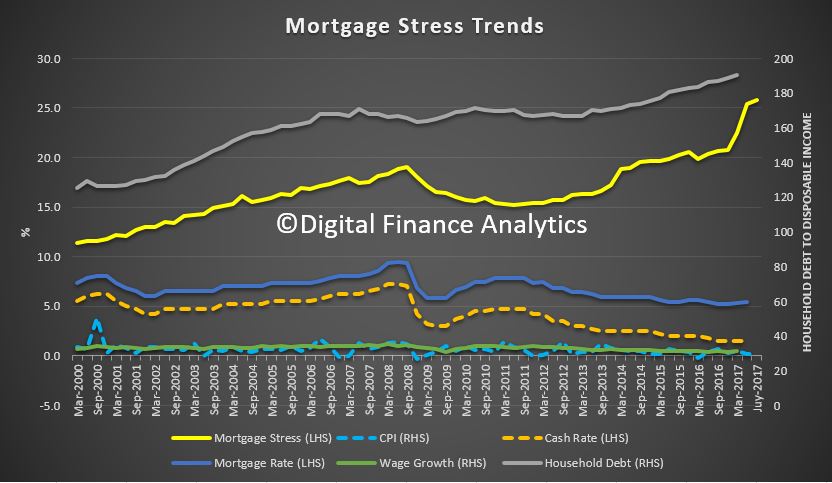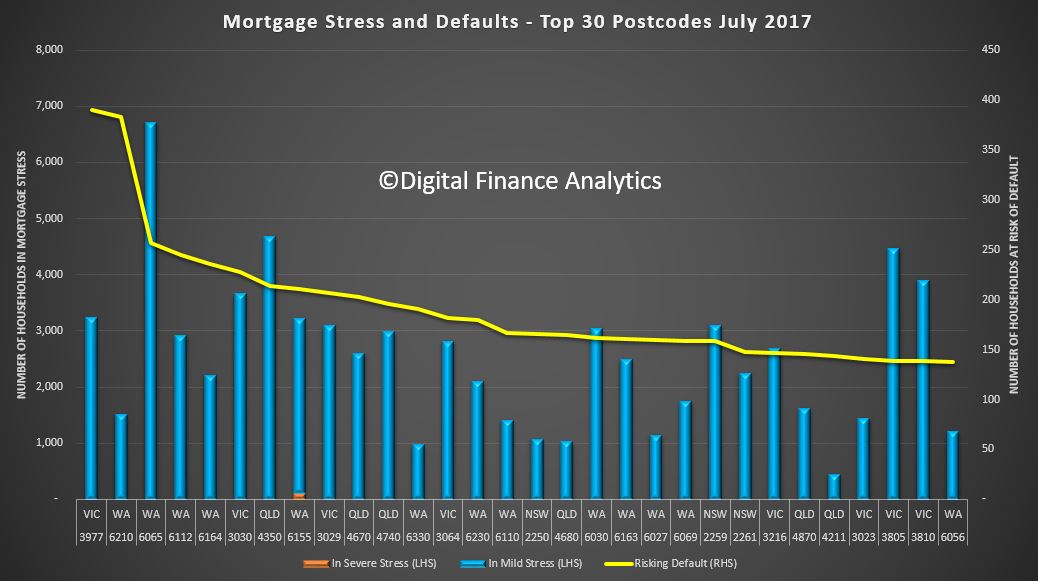Digital Finance Analytics has released mortgage stress and default modelling for Australian mortgage borrowers, to end July 2017. Across the nation, more than 820,000 households are estimated to be now in mortgage stress (last month 810,000) with 20,000 of these in severe stress. This equates to 25.8% of households, up from 25.4% last month. We also estimate that nearly 53,000 households risk default in the next 12 months, 2,000 down from last month.
We have been tracking the number of households in stress each month since 2000, and since a small easing in February 2016, the number under pressure have been rising each month. The RBA cash rate cuts have provided some relief, especially directly after the GFC, but now mortgage rates appear to be more disconnected from the cash rate as banks seek to rebuild their margins.
 The main drivers of stress are rising mortgage rates and living costs whilst real incomes continue to fall and underemployment is on the rise. This is a deadly combination and is touching households across the country, not just in the mortgage belts. On the other hand, employment remains strong in NSW in particular, so income rose a little and small reductions in some owner occupied mortgage rates helped too.
The main drivers of stress are rising mortgage rates and living costs whilst real incomes continue to fall and underemployment is on the rise. This is a deadly combination and is touching households across the country, not just in the mortgage belts. On the other hand, employment remains strong in NSW in particular, so income rose a little and small reductions in some owner occupied mortgage rates helped too.
This analysis uses our core market model which combines information from our 52,000 household surveys, public data from the RBA, ABS and APRA; and private data from lenders and aggregators. The data is current to end July 2017.
We analyse household cash flow based on real incomes, outgoings and mortgage repayments. Households are “stressed” when income does not cover ongoing costs, rather than identifying a set proportion of income, (such as 30%) going on the mortgage.
Those households in mild stress have little leeway in their cash flows, whereas those in severe stress are unable to meet repayments from current income. In both cases, households manage this deficit by cutting back on spending, putting more on credit cards and seeking to refinance, restructure or sell their home. Those in severe stress are more likely to be seeking hardship assistance and are often forced to sell.
Martin North, Principal of Digital Finance Analytics said “flat incomes and underemployment mean rising costs are not being managed by many, and when added to rising mortgage rates, household budgets are really under pressure. Those with larger mortgages are more impacted by rate rises”.
“The latest housing debt to income ratio is at a record 190.4[1] so households will remain under pressure. Stressed households are less likely to spend at the shops, which acts as a drag anchor on future growth. The number of households impacted are economically significant, especially as household debt continues to climb to new record levels.”
“We continue to see the spread of mortgage stress in areas away from the traditional mortgage belts. A rising number of more affluent households are also being impacted.”
Regional analysis shows that NSW has 225,090 households in stress, VIC 229,988 (217,655 last month), QLD 144,825 (141,111 last month) and WA 107,936 (106,984 last month). The probability of default fell a little, with around 10,000 in WA, around 10,000 in QLD, 13,000 in VIC and 14,000 in NSW. There were falls of about 1,000 from last month in NSW and VIC, thanks to improved employment prospects. Probability of default extends our mortgage stress analysis by overlaying economic indicators such as employment, future wage growth and cpi changes.
Here are the top 30 post codes sorted by risk of default estimated over the next 12 months.
 [1] *RBA E2 Household Finances – Selected Ratios March 2016
[1] *RBA E2 Household Finances – Selected Ratios March 2016


2 thoughts on “Mortgage Stress Gets Worse in July”